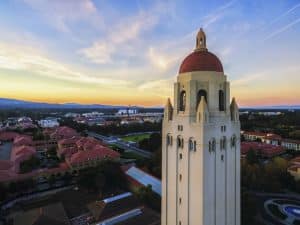How Big Is Stanford University?
Universities are sprawling entities that encompass much more than buildings for classes; they’re often integral parts of their local communities, offering spaces for arts, research, athletics, and more. One such institution is Stanford University, situated in California’s Bay Area. But just how big is Stanford University? Let’s delve into its size and campus to find out.
Understanding the Size of Stanford University
While assessing the size of a university, consider several factors—its physical space, the number of students, faculty, and staff, and its scalability or potential for future expansion. Through this comprehensive lens, we’ll explore the scope of Stanford University.
Measuring the Physical Size of Stanford
Regarding landmass, Stanford University boasts a place amongst some of the largest in the USA. It is spanning 8,180 acres or about 13 square miles. The campus impresses in its size and design, including beautiful nature trails, the iconic Main Quadrangle, and modern facilities.
The expansive territory also holds the Stanford Research Park, a key player in Silicon Valley’s growth, and the Jasper Ridge Biological Preserve, offering a haven for biodiversity research.
As you stroll through the campus, you’ll come across stunning architectural wonders like the Hoover Tower, a 285-foot-tall structure that provides panoramic views of the surrounding area. The Stanford campus blends historic buildings like the Memorial Church and contemporary designs like the Bing Concert Hall, which hosts world-class performances.
Student Population: A Different Measure of Size
Moving from landmass to people, one must examine the university’s student population. As of 2021, Stanford has over 17,000 students, with a reasonably equal distribution between undergraduate and post-graduate students.
Within this diverse student body, you’ll find individuals from around the globe, each bringing their unique perspectives and experiences to campus. Stanford’s commitment to fostering a vibrant and inclusive community ensures that students can access various cultural, academic, and extracurricular opportunities.
Despite its large campus, Stanford’s dedication to providing a near-peerless student-teacher ratio makes it a highly sought-after university. This intimate setting fosters a unique learning environment where students aren’t just numbers but recognized and valued individuals.
Regarding student life, Stanford offers an array of student organizations, clubs, and sports teams catering to a wide range of interests. From the Stanford Solar Car Project to the Stanford Improvisors, there is something for everyone to get involved in and make lasting connections.
Faculty and Staff: Another Aspect of University Size
Stanford’s composition wouldn’t be complete without mentioning its faculty and staff. The university employs over 2,000 faculty members, a testament to the broad diversity of subjects taught at Stanford, and more than 12,000 staff members who keep the campus running smoothly.
These dedicated individuals are experts in their respective fields, bringing a wealth of knowledge and experience to the Stanford community. From Nobel laureates to Pulitzer Prize winners, the faculty at Stanford are at the forefront of groundbreaking research and innovation.
Behind the scenes, the staff members work tirelessly to ensure the campus functions seamlessly. From maintaining beautiful landscaping to providing essential support services, they play a crucial role in creating a conducive environment for learning and growth.
Moreover, Stanford’s commitment to diversity and inclusion extends to its faculty and staff, with efforts to recruit and retain individuals from underrepresented backgrounds. This commitment enriches the academic and professional environment, fostering a culture of collaboration and excellence.
Stanford University’s size is not just about its physical expanse or the number of students, faculty, and staff it accommodates. It is a vibrant community where ideas are nurtured, discoveries are made, and lifelong connections are formed. Whether you’re exploring the sprawling campus or engaging in intellectual discourse, Stanford’s size becomes a testament to its impact on the world.
The Layout of the Stanford University Campus
Regarding Stanford University, it’s not just about the numbers. This prestigious institution is renowned for its academic excellence and meticulously designed campus layout, which perfectly blends form and function.
Let’s take a closer look at the main campus of Stanford University. Despite its intimidating size, the primary campus is built around the Main Quad, creating a central hub that makes navigation easy for students, faculty, and visitors. This hub is aesthetically pleasing and is the heart of academic and administrative activities.
It is home to many important buildings, including the heritage Hoover Tower, which stands tall as a symbol of the university’s rich history. As you stroll through the Main Quad, you’ll also come across scenic spots like the Oval Lawn and Memorial Court, where students often gather to relax, study, or engage in lively discussions.
But Stanford’s campus is not just about academics. It also boasts a vibrant cultural facet. The Cantor Center for Visual Arts, a world-class art museum, is on campus. Students and art enthusiasts here can explore artworks spanning various periods and genres. Additionally, with its state-of-the-art facilities, the Bing Concert Hall hosts a wide range of musical performances, adding a melodic touch to campus life.
While the main campus is undoubtedly impressive, Stanford’s reach extends beyond its borders. The university has established off-site facilities that provide unique educational experiences for its students. For instance, the Hopkins Marine Station in Monterey is a marine study hub. Here, students can conduct research and engage in hands-on learning in a coastal environment. Furthermore, Stanford operates astronomical observatories in remote locations, allowing students and researchers to explore the mysteries of the universe.
Looking toward the future, Stanford University continues to grow and expand. The university has ambitious plans for new dormitories, academic buildings, and research facilities. These strategic developments ensure that Stanford remains at the forefront of higher education, providing its students with the best possible learning environment and opportunities for innovation.
Comparing Stanford’s Size to Other Universities
One may ask how Stanford’s size compares to other universities. Here’s a quick comparison.
Stanford Vs. Ivy League Schools
When compared to Ivy League campuses, Stanford’s sprawling landmass is notable. It is larger than Cornell, the biggest Ivy League, which is approximately 4800 acres. Stanford’s vast campus provides ample space for academic buildings and facilities and plenty of room for outdoor activities.
With its expansive grounds, students can enjoy picturesque landscapes, lush gardens, and serene pathways that enhance their learning experience. Moreover, the size of Stanford’s campus allows for integrating various research centers and institutes, fostering a collaborative environment where scholars from different disciplines can come together to tackle complex global challenges.
Stanford Vs. Other California Universities
Even within California, Stanford stands out. While UC Santa Cruz has a larger campus, Stanford dwarfs other well-known institutions, such as UC Berkeley and UCLA, in terms of physical size.
Stanford’s vastness contributes to its aesthetic appeal and provides numerous opportunities for students to explore and engage in extracurricular activities. The campus boasts extensive sports facilities, including state-of-the-art stadiums, courts, and fields, where students can participate in multiple sports and athletic programs.
Additionally, Stanford’s size allows for the establishment of numerous student organizations, clubs, and societies catering to diverse interests and passions. From academic clubs to cultural associations, there is something for everyone, fostering a vibrant and inclusive campus community.
Furthermore, the expansive campus provides ample space for innovative architectural designs, allowing for the constructing of cutting-edge research facilities and laboratories. This facilitates groundbreaking research and enables Stanford to remain at the forefront of scientific and technological advancements.
How Stanford’s Size Impacts Its Education
Stanford’s grandeur is not just for show—it significantly influences its educational environment. The size of Stanford University plays a crucial role in shaping the experiences and opportunities available to its students. Let’s delve deeper into how the university’s size impacts various aspects of education at Stanford.
Class Sizes and Student-to-Faculty Ratio
Despite its vast student population, Stanford maintains small class sizes, which promotes personalized interactions and practical learning. This commitment to small class sizes allows students to engage in meaningful discussions, receive individual attention from professors, and actively participate in their academic journey.
With close to a 5:1 student-faculty ratio, Stanford garners praise for its focus on fostering quality relationships between students and professors. This intimate learning environment enables students to develop strong mentorships, seek guidance, and collaborate with renowned scholars in their respective fields.
Research Opportunities and Facilities
The extensive campus offers students ample research opportunities. Stanford’s commitment to cutting-edge research is evident in its state-of-the-art facilities and resources. From the high-tech labs in the Research Park to Stanford’s accelerator, StartX, space fosters creativity, innovation, and discovery for budding entrepreneurs.
Students are privileged to work alongside world-class researchers, contribute to groundbreaking studies, and push the boundaries of knowledge. With its vast size and resources, Stanford University has rightfully earned its reputation as a global leader in research.
Campus Life and Student Activities
Beyond academics, campus size impacts students’ quality of life. Stanford’s expansive campus boasts over 650 student organizations, diverse dining halls, athletic facilities, and generous green space for leisure and activity.
The sheer size of the campus creates a vibrant and dynamic environment, fostering a sense of community and providing countless opportunities for students to explore their interests outside the classroom.
Whether it’s joining a student club, participating in intramural sports, or attending cultural events, Stanford offers a multitude of avenues for students to engage, connect, and grow. The overall spirit of the Stanford community thrives vibrantly within this edible campus.
In closing, “big” for Stanford is not just in terms of its physical presence but the depth of experiences it offers students and its contributions to its community and the world. Stanford University’s size is not merely a number but a testament to its commitment to providing an exceptional education, fostering groundbreaking research, and nurturing a vibrant community. The vastness of Stanford illuminates the boundless opportunities available to its students, shaping them into future leaders and change-makers.
Ready to Be a Part of Stanford University? Let AdmissionSight Guide You.
So, you’ve delved deep into the intricate layers that constitute Stanford University’s ‘size.’ Fascinating. But as you soak up these facts and figures, a question might bubble up: how do you fit into this massive, multifaceted institution? That’s where AdmissionSight comes in.
AdmissionSight is your go-to destination for tailored, results-driven college admission consulting.
- Expert Guidance: Our seasoned consultants are well-versed in the nuances of Stanford’s admissions process. Trust us; we’ve covered you from the Common App to those pesky supplemental essays.
- In-Depth Profile Analysis: Do you have what Stanford’s looking for? Let us analyze your academic and extracurricular profile. We can identify your strengths and strategize on how to magnify them.
- Essay Excellence: Considering you’re aiming for a university with an academic scope as broad as the campus, your essays must hit the mark. Our team of highly skilled copywriters ensures that your story is told in a way that captivates the admissions officers.
- Financial Aid Assistance: We don’t just stop at getting you admitted; we’re here to ensure your education is affordable. Let’s navigate the complex landscape of scholarships, grants, and work-study options together.
So, why go alone when you can walk this complex path with experts who have navigated it countless times? Don’t just dream about Stanford; let’s strategize to make you a part of this monumental institution. Because you’re not just a statistic—you’re the next big thing on a campus that values ‘bigness’ in all its forms.









































